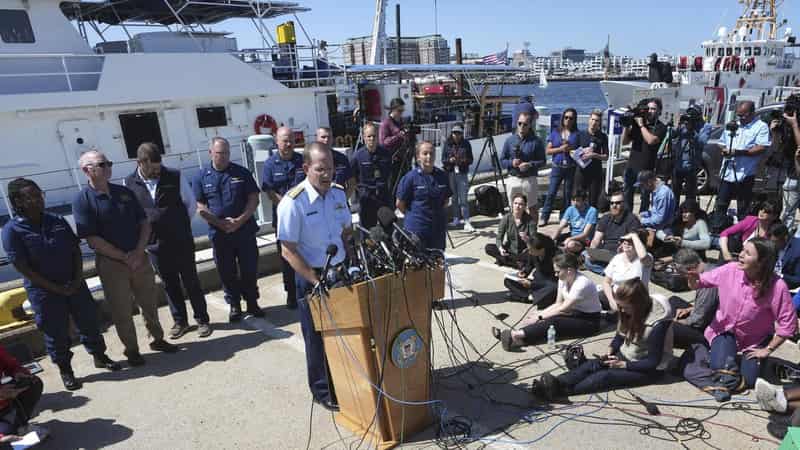
Relatives and colleagues have mourned five people who died when their submersible imploded in the North Atlantic during a deep dive to the Titanic wreck, triggering questions from experts about safety rules for such adventures.
Debris from the Titan submersible, which had been missing since Sunday, was detected on Thursday by a robotic diving vehicle deployed from a Canadian ship as part of an international rescue effort.
Remains of the submersible, which lost contact with a surface ship about 1 hour and 45 minutes into a two-hour descent, were discovered on the seabed about 490 metres from the bow of Titanic wreck, about four kilometres below the surface, US Coast Guard Rear Admiral John Mauger said on Thursday.
He told reporters the debris was consistent with "a catastrophic implosion of the vehicle".
The five who died included Stockton Rush, US founder and chief executive officer of OceanGate Expeditions, which operated the submersible and charged $US250,000 ($A370,000) per person to make the Titanic trip. He was piloting the craft.
The others were British billionaire and explorer Hamish Harding, 58; Pakistani-born businessman Shahzada Dawood, 48, and his 19-year-old son, Suleman, both British citizens; and French oceanographer and Paul-Henri Nargeolet, 77.
"These men were true explorers who shared a distinct spirit of adventure, and a deep passion for exploring and protecting the world's oceans," OceanGate said.
A statement issued by the British Asian Trust on behalf of the Dawood family read: "With profound sorrow, we mourn the tragic loss of Shahzada and his beloved son, Suleman, who had embarked on a journey to visit the remnants of the legendary Titanic in the depths of the Atlantic Ocean."
Teams from the United States, Canada, France and Britain had spent days scanning a vast swathe of open sea for the Titan.
The US Navy said an analysis of acoustic data detected "an anomaly consistent with an implosion or explosion" near the submersible's location when communication with Titan was lost.
A senior Navy official said in a statement first quoted by the Wall Street Journal that its information "while not definitive" was shared with commanders of the search mission.
The Journal, citing unnamed US defence officials, said the sound was picked up by a system used to detect enemy submarines.
Moviemaker James Cameron, who directed the 1997 Oscar-winning film Titanic that did much to revive global interest in the British ocean liner that sank in 1912, said he learned of the acoustic findings within a day and knew what it meant.
"I sent emails to everybody I know and said we've lost some friends. The sub had imploded. It's on the bottom in pieces right now. I sent that out Monday morning," Cameron, who has ventured to the wreck in submersibles, told Reuters.
Questions about Titan's safety were raised in 2018 during a symposium of submersible industry experts and in a lawsuit by OceanGate's former head of marine operations, which was settled later that year.
"There may be calls for more regulation, better understanding of how these sorts of vehicles are designed, built and certified for use in these deep sea environments," said Stefan Williams, professor of marine robotics at the University of Sydney.
Scientist and journalist Michael Guillen, who survived an expedition in 2000 that became trapped in the wreck's propeller, said: "Whether we find the vessel and determine what went wrong with this vessel, we need to stop, pause and ask this question, why do you want to go to the Titanic and how do you get there safely?"
The Titanic sank after hitting an iceberg on its first voyage, killing more than 1500 people aboard. It lies about 1450km east of Cape Cod, Massachusetts, and 640km south of St. John's, Newfoundland.









